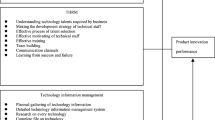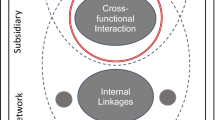Abstract
Latecomer firms from emerging economies upgrade their technological capabilities by providing original equipment manufacturer (OEM) services to multi-national enterprises from advanced countries and extend their role across the global value chains. Existing firm-level taxonomies of knowledge accumulation cannot explain why most latecomer firms fail to transit to advanced levels in high-tech manufacturing industries. The proposed framework combines firm-level taxonomy of knowledge accumulation with catch-up trajectory to argue that, under the knowledge regime of a high-tech manufacturing industry, latecomers’ learning experience differs from those as posited by previous studies. Using the integrated circuit industry as the empirical anchor, this paper shows that firms undergo ‘critical transition’ in learning which involves sustainable innovative capacity and momentum-generation to reach the advanced level. It shows how OEMs build knowledge to leapfrog incumbents without competing with their branded customers. Throughout the process, inter-firm collaboration and open innovation are critical sources of knowledge.




Similar content being viewed by others
References
Amsden AH (1989) Asia’s Next Giant: South Korea and Late Industrialisation. Oxford University Press, New York.
Amsden AH and Tschang FT (2003) A new approach to assessing the technological complexity of different categories of R&D (with examples from Singapore). Research Policy 32(4), 553–572.
Ariffin N and Bell M (1999) Firms, politics and political economy: patterns of subsidiary-parent linkages and technological capability building in electronics TNCs in Malaysia. In Industrial Technology Development in Malaysia: Industry and Firm Studies (Jomo KS, Felker G and Rasiah R, Eds), pp 150–190, Routledge, London.
Ariffin N and Figueiredo P (2004) Internationalisation of innovative capabilities: counter-evidence from the electronics industry in Malaysia and Brazil. Oxford Development Studies 32(4), 559–583.
Barcelo-Valenzuela M, Sanchez-Schmitz G, Perez-Soltero A, Rubio FM and Palma J (2008) Defining the problem: key element for the success of knowledge management. Knowledge Management Research & Practice 6(4), 322–333.
Bell M and Pavitt K (1995) The development of technological capabilities. In Trade, Technology and International Competitiveness (Haque IU, Ed), pp 69–101, World Bank, Washington DC.
Best M (2001) The New Competitive Advantage. Oxford University Press, Oxford.
Best M and Rasiah R (2003) Malaysian Electronics at the Crossroads. United Nations Industrial Development Organization, Vienna.
Brown C and Linden G (2009) Chips and Change: How Crisis Reshapes the Semiconductor Industry. The Massachusetts Institute of Technology (MIT) Press, Cambridge.
Cadence (2014) Cadence and SMIC partnership. [WWW document] http://www.cadence.com/Alliances/foundry_program/smic/pages/default.aspx (accessed 30 December 2014).
Chang S and Lee M (2008) The linkage between knowledge accumulation capability and organizational innovation. Journal of Knowledge Management 12(1), 3–20.
Chesbrough H (2003) Open Innovation: The New Imperative for Creating and Profiting From Technology. Harvard Business School Press, Boston.
Chesbrough H (2006) Open Business Models: How to Thrive in the New Innovation Landscape. Harvard Business School Press, Boston.
CLSA Research (2013) CLSA Asia-Pacific markets research database. Requested data. [WWW document] https://www.clsa.com/home.php (accessed 13 June 2013).
CNSE – College for Nanoscale and Science Engineering (2012) CNSE’s Albany NanoTech complex. [WWW document] http://cnse.albany.edu/WorldClassResources/CNSEAlbanyNanoTechComplex.aspx (accessed 30 April 2013).
Cohen W and Levinthal D (1990) Absorptive capacity: a new perspective on learning and innovation. Administrative Science Quarterly 35(1), 128–152.
Conner K and Prahalad C (1996) A resource-based theory of the firm: knowledge versus opportunism. Organization Science 7(5), 477–501.
Credit Suisse Research (2013) Foundry database. Requested data. [WWW document] https://www.credit-suisse.com/ch/en/investment-banking/indices-research-analytics.html (accessed 15 June 2013).
Cricelli L and Grimaldi M (2008) A dynamic view of knowledge and information: a stock and flow based methodology. International Journal of Management and Decision Making 9(6), 686–698.
Cricelli L and Grimaldi M (2010) Knowledge-based inter-organizational collaborations. Journal of Knowledge Management 14(3), 348–358.
DeCarolis D and Deeds D (1999) The impact of stocks and flows of organizational knowledge on firm performance: an empirical investigation of the biotechnology industry. Strategic Management Journal 20(10), 953–968.
Dolphin Integration (2009) SMIC and Dolphin integration announce strategic partnership for portable media players. [WWW document] http://www.dolphin.fr/index.php/newsroom/news/60 (accessed 28 December 2014).
Dosi G (1982) Technological paradigms and technological trajectories. Research Policy 11, 147–162.
Figueiredo P (2008) Industrial policy changes and firm-level technolo-gical capability development: evidence from Northern Brazil. World Development 36(1), 54–92.
Figueiredo P (2013) Embedding with multiple knowledge sources to improve innovation performance: the learning experience of Motorola in Brazil. Knowledge Management Research & Practice 11, 361–373.
Gartner (2013) Fab database: worldwide, second quarter 2012 update. Requested data [WWW document] http://www.gartner.com/technology/research.jsp (accessed 31 August 2012).
Gerschenkron A (1952) Economic backwardness in historical perspective. In The Sociology of Economic Life (Granovetter M and Swedberg R, Eds), pp 111–130, Westview Press, Boulder, CO.
Gläser J and Laudel G (2013) Life with and without coding: two methods for early-stage data analysis in qualitative research aiming at causal explanations. Forum: Qualitative Social Research 14(2)Art. 5.
Grant R (1996) Toward a knowledge-based theory of the firm. Strategic Management Journal 17(Winter Special Issue), 109–122.
Grant R and Baden-Fuller C (1995) A knowledge-based theory of inter-firm collaboration. Academy of Management Best Paper Proceedings, (1 August): 17–21.
Hampden-Turner C (1990) Charting the Corporate Mind. Free Press, New York.
Hobday M (1995) Innovation in East Asia: The challenge to Japan. Edward Elgar, Hants.
Hu M-C and Mathews J (2005) National innovative capacity in East Asia. Research Policy 34, 1322–1349.
Hu M-C and Mathews J (2008) China’s national innovative capacity. Research Policy 37, 1465–1479.
Kim L (1997) From Imitation to Innovation. Harvard Business School Press, Cambridge.
Kim L (1998) Crisis construction and organisational learning: capability building in catching up at Hyundai motor. Organization Science 9(4), 506–521.
Kim L and Lee H (1987) Patterns of technological change in a rapidly developing country: a synthesis. Technovation 6(4), 261–276.
Knott A, Bryce D and Posen H (2003) On the strategic accumulation of intangible assets. Organization Science 14(2), 192–207.
Kogut B and Zander U (1992) Knowledge of the firm, combinative capabilities, and the replication of technology. Organization Science 3(3), 383–397.
Lall S (1992) Technological capabilities and industrialisation. World Development 20(2), 165–186.
Lall S (2000) The technological structure and performance of developing country manufactured exports, 1985–98. Oxford Development Studies 28(3), 337–369.
Lall S, Albaladejo M and Zhang J (2004) Mapping fragmentation: electronics and automobiles in East Asia and Latin America. Oxford Development Studies 32(3), 407–432.
Lee K and Lim C (2001) Technological regimes, catching up and leapfrogging: findings from the Korean industries. Research Policy 30(3), 459–483.
Lundvall B (1992) National Systems of Innovation. Towards a Theory of Innovation and Interactive Learning. Pinter Publishers, London.
Malerba F and Nelson R (2012) Economic Development As a Learning Process: Differences Across Sectoral Systems. Edward Elgar, Cheltenham.
Mathews J and Cho DS (2000) Tiger Technology: The Creation of a Semiconductor Industry in East Asia. Cambridge University Press, Cambridge.
Mathews J (2002) Competitive advantages of the latecomer firm: a resource-based account of industrial catch-up strategies. Asia Pacific Journal of Management 19(4), 467–488.
Mathews J (2006) Catch-up strategies and the latecomer effect in industrial development. New Political Economy 11(3), 313–335.
Nelson R (2008) Economic development from the perspective of evolutionary economic theory. Oxford Development Studies 36(1), 9–21.
Nelson R (2012) Why Schumpeter has had so little influence on today’s main line economics, and why this may be changing. Journal of Evolutionary Economics 22(5), 901–916.
Nelson R and Winter S (1977) In search of a useful theory of innovation. Research Policy 6(1), 36–76.
Nelson R and Winter S (1982) An Evolutionary Theory of Economic Change. Harvard University Press, Cambridge.
Nelson R and Winter S (2002) Evolutionary theorizing in economics. The Journal of Economic Perspectives 16(2), 23–46.
Nonaka I (1991) The knowledge creating company. Harvard Business Review 69(6), 96–104.
Pavitt K (1984) Sectoral patterns of technical change: towards a taxonomy and a theory. Research Policy 13, 343–373.
Pavitt K (1998) Technologies, products and organization in the innovating firm: what Adam Smith tells us and Joseph Schumpeter doesn’t. Industrial and Corporate Change 7(3), 433–451.
Penrose E (1959) The Theory of the Growth of the Firm. Oxford University Press, New York.
Perez C (1988) New technologies and development. In Small Countries Facing the Technological Revolution (Freeman C and Lundvall B, Eds), pp 85–97, Pinter Publishers, London.
Powell W (1998) Learning from collaboration: knowledge and networks in the biotechnology and pharmaceutical industries. California Management Review 40(3), 227–240.
Powell W, Koput K and Smith-Doerr L (1996) Interorganizational collaboration and the locus of control of innovation: networks of learning in biotechnology. Administrative Science Quarterly 41(1), 116–145.
Prahalad C and Hamel G (1990) The core competence of the corporation. Harvard Business Review 68(3), 79–91.
Ramirez R (1999) Value co-production: intellectual origins and implications for practice and research. Strategic Management Journal 20(1), 49–65.
Rasiah R (2010) Are electronics firms in Malaysia catching up in the technology ladder? Journal of Asia Pacific Economy 15(3), 301–319.
Rodrik D (2006) Industrial Development: Stylized Facts and Policies. Harvard University, John F. Kennedy School of Government, Cambridge, MA.
Rothaermel F and Deeds D (2004) Exploration and exploitation alliances in biotechnology: a system of new product development. Strategic Management Journal 25(3), 201–221.
Schumpeter J (1943) Capitalism, Socialism and Democracy. Allen & Unwin, London.
Shipp et al (2012) Emerging global trends in advanced manufacturing. Institute for Defense Analyses. IDA Paper P-4603, Alexandria, Virginia.
Spender J (1989) Industry Recipes: The Nature and Sources of Managerial Judgment. Blackwell, Oxford.
Sydow J, Schreyong G and Koch J (2009) Organizational path dependence: opening the black box. Academy of Management Review 34(4), 689–709.
Todorova G and Durisin B (2007) Absorptive capcity: valuing a reconceptualization. Academy of Management Review 32(3), 774–786.
Tsai W (2000) Social capital, strategic relatedness, and the formation of intra-organizational strategic linkages. Strategic Management Journal 21(9), 925–939.
UNIDO (2002) Industrial development report 2002/2003. Chapter 6. United Nations Industrial Development Organization, Vienna.
Vanhaverbeke W, Cloodt M and Vrande V (2008) Connecting absorptive capacity and open innovation. SSRN Working Paper No. 1091265, February 2008.
Veblen T (1915) Imperial Germany and the Industrial Revolution. Batoche Books, Kitchener.
Vind I (2008) Transnational companies as a source of skill upgrading: the electronics industry in Ho Chi Minh City. Geoforum 39(3), 1480–1493.
Winter S (1987) Knowledge and competence as strategic assets. In The Competitive Challenge: Strategies for Industrial Innovation and Renewal (Teece DJ, Ed), pp 159–184, Ballinger, Cambridge MA.
Yin R (2011) Qualitative Research from Start to Finish. The Guilford Press, New York.
Yin R (2014) Case Study Research: Design and Methods (Applied Social Research Methods). SAGE Publications, California.
Author information
Authors and Affiliations
Corresponding author
Rights and permissions
About this article
Cite this article
Yap, XS., Rasiah, R. Catching up and leapfrogging in a high-tech manufacturing industry: towards a firm-level taxonomy of knowledge accumulation. Knowl Manage Res Pract 15, 114–129 (2017). https://doi.org/10.1057/kmrp.2015.21
Published:
Issue Date:
DOI: https://doi.org/10.1057/kmrp.2015.21




